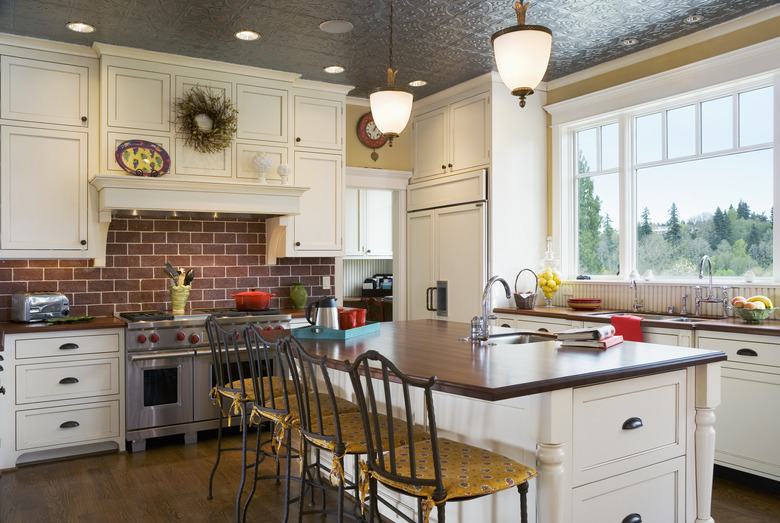How To Paint Old Ceiling Tiles
We may receive a commission on purchases made from links.
Ceiling tiles, whether glued to the ceiling or suspended on a metal grid, tend to acquire stains and discolor from age. To freshen your décor, you can prep, prime, and paint old ceiling tiles. Don't limit yourself to the original whites or creams; you can choose a matte or satin metallic, soothing colors, or period-appropriate paints to fit your vision of a newly decorated home. Here's how to paint old ceiling tiles.
Prepping to Paint
Prepping to Paint
Prepare for painting by covering the floor and furniture with plastic sheeting or painter's drop cloths. While you can put a tarp down after taking down removable ceiling tiles, you're likely to find an assortment of dust bunnies, dead spiders, and other debris above a suspended ceiling. When painting ceiling tiles that are permanently attached to the ceiling, protect the walls and ceiling fixtures with painter's tape and/or pretaped painter's plastic, available in 24- and 48-inch widths.
Put on safety goggles, gloves, a mask, and other protective gear before you begin prepping the ceiling tiles. You'll need a ladder to reach the tiles. Wipe down the tiles and let them dry at least overnight.
Metal and plastic tiles may also need a light sanding to ensure that the new paint bonds with the surface. In addition, repair damaged tiles with all-purpose spackle or caulk to cover dents and fill holes. Allow the caulk to dry completely; then sand lightly. Remove dust and debris with a tack cloth.
Priming Before Painting
Priming Before Painting
Unless you're using a ceiling paint that incorporates a primer, use a stain-sealing primer like Kilz before painting heavily stained acoustic ceiling tiles. Plastic, cork, and/or metal ceiling tiles also need an appropriate primer formulated for the specific material before applying fresh paint. Cork tiles soak up primer and paint; apply at least two coats of shellac-based primer and allow it to dry according to the directions before applying the final paint colors.
If you're changing the color of the ceiling tiles, consider having the primer tinted to the same or a slightly lighter color. When painting a brighter or dark color, a tinted primer helps smooth the underlying tones, intensifies the depth of the color, and reduces the number of final coats. Follow these steps for priming the tiles:
- Open the windows for ventilation.
- Turn on exhaust fans and, if possible, put a box or window fan in front of the door to pull fumes out of the room.
- Roll or spray the first coat of primer onto the tiles.
- Allow the tiles to dry for the recommended time.
- If necessary, apply a second coat of primer to completely cover the tiles.
Painting Old Ceiling Tiles
Painting Old Ceiling Tiles
After waiting for the primer to dry, repeat the process and paint the old ceiling tiles. However, if you used a shellac primer, such as those used on cork tiles, it may be necessary to lightly sand the primer coat before applying the paint. Ceiling paints are usually thicker than standard interior house paint, with a flat or matte finish. If you're unable to find a ceiling paint that you can tint to your specification, you can use a low-VOC interior flat or matte latex paint.
Apply two coats of paint, giving them time to dry. When painting old tiles that are attached to the ceiling, use an extension pole and a roller with a 1/2- or 3/4-inch nap, depending on the texture, and work in 3- to 5-foot sections. While the ceiling tiles are drying, remove the painter's tape around the edges of the room.
